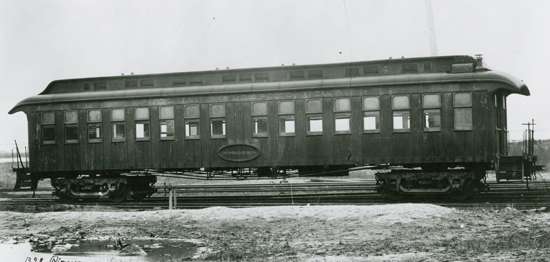What is a Pullman Car?

No one asked that question, but that’s not going to stop me from diving straight in, since the history of Pullman rail cars is simply too interesting. Plus it takes me right back to my ol’ home town: Chicago. And I haven’t been back there in what…a week?
Pullman cars were the product of the Pullman Palace Car Company, owned by one George Pullman who came to prominence as a rail car maker just after the Civil War. American rail networks were expanding rapidly in those days, and not a few manufacturers were vying for supremacy as America’s go-to passenger car. Pullman invented an innovative sleeping car design, with fold-up berths above and seats below, a design that hasn’t been much improved upon to this day. The first prototypes rolled off the assembly line in 1864.
Still Pullman’s products, though more luxurious than most others, were just more rail cars until history intervened in Pullman’s favor: Abraham Lincoln was assassinated. That was in 1865, and as it happened the Pullman Company had only recently provided the Lincoln administration with a special car designed for state travel. That car, draped in funerary decor, became the centerpiece of the famous Lincoln “funeral train” which passed through the Eastern U.S. — and past hundreds of thousands of mourning Americans — on its way from Washington D.C. to Lincoln’s home town of Springfield, Illinois.
After that Pullman’s cars were famous. Demand exploded and he began producing sleeping cars by the hundreds. Two years later Pullman introduced his next level of luxury, the President car which contained not only private sleeping berths but a kitchen and dining car that served food to rival the finest hotels. Ten years later Pullman owned a fleet of 700 cars and demand was still rising. In 1880 he began construction of his own company town — called Pullman — just south of Chicago, America’s rail hub.
For the next sixty years the Pullman Palace Car would reign supreme on America’s railroads. At the company’s peak in the late 1920’s it operated almost 10,000 cars. On any given night in America, 100,000 people were asleep in a Pullman car. However as the 20th Century wore on the company began to experience headwinds. The rise of the automobile began to take the shine off of rail travel. In the 1930’s lighter steel cars, rather than Pullman’s heavy wooden ones, came into vogue. A devastating antitrust suit brought by the Federal Government in 1943 broke the company up into several independent pieces. Then in the 50’s and early 60’s came the final coup de grâce: jet travel, which brought a more modern and more glamorous mode of long-distance transportation to America. Pullman Inc. carried on making railcars, subway cars and even ships up until about 1970 when the company was finally shuttered for good.
However where rail travel is concerned, George Pullman will always be remembered as the Henry Ford of the industry, and the Palace Car its Model T.
It’s already occurred this year, but I highly recommend getting to a station on National Train Day in May (http://en.wikipedia.org/wiki/National_Train_Day). I’ve been able to tour quite fancy cars maintained by private owners, along with some Amtrak has. There’s a dream after winning the lottery.
Great, Naomi! Thanks very much!
– Joe
Is that where we get the name Pullman Loaf from? I never put the two together and the bread does look just like the Pullman car.
Fascinating stuff. The pan really does look like the railway car. (It’s those right angles, they’re amazing.) Makes you wonder about the more prosaic pain de mie. How dull!
Back to bread: do you have a recipe for a sourdough Pullman loaf? I’m trying to revive my starter. (I discovered some in the freezer, it’s marked March 2010 but it is starting to show signs of life.) I have a lot of trouble with amounts and equivalencies for the Pullman loaf, and sourdough makes it even more of a puzzle, I never know how much that stuff is going to rise.
Thanks!
Hey Chana!
I don’t have one, but you can create your own by substituting starter for a third of the dough and proceeding as normal!
– Joe
“At the company’s peak in the late 1920?s it operated almost 10,000 cars.”
Did the Pullman Company sell cars or did it sell the service “running cars for the railways”? I didn’t really think of that distinction before I learned that there are companies who sell not light bulbs, but illumination and found that to be quite an interesting concept.
Thanks!
upT
Ah yes! Great question. Pullman cars were like roving hotels. They were owned and operated by the Pullman company and the people who worked on them were Pullman employees, even though they were pulled along by engines and rode on tracks owned by other companies.
– Joe